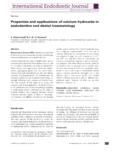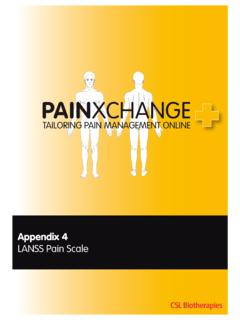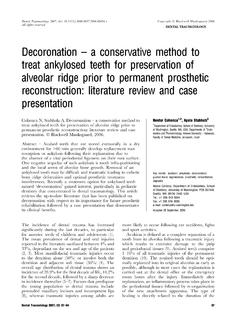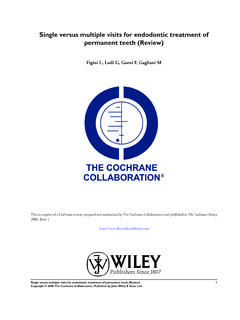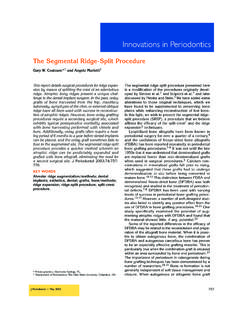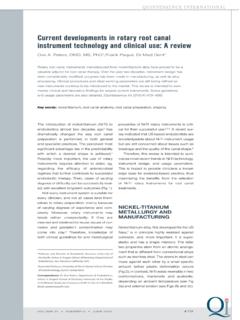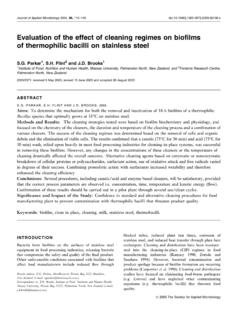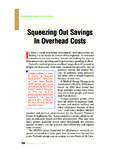Transcription of The pregnant patient: Considerations for dental …
1 VOLUME 38 NUMBER3 MARCH2007e133 QUINTESSENCE INTERNATIONALO verestimation of the risk of teratogenicity inthe fetus resulting from medical and dentalprocedures or drugs may cause a clinician toavoid necessary treatment of the expectantmother. During pregnancy, dental treatmentmay be modified but need not be withheld,provided that the risk assessment is madeproperly for both the patient and the present paper points out the alterationsin physiology during pregnancy and reviewsthe current Considerations for the pregnantdental patient, including safety of the drugsused in dental treatment, common dentalprocedures, and recommendations for main-taining oral health.
2 PHYSIOLOGIC CHANGESASSOCIATED WITH PREGNANCYP regnancy causes profound and remarkablechanges in all organ dentalteam should be aware of the altered physio-logic status of the pregnant patient to avoidinappropriate interpretation of normalchanges as pathologic. With pregnancy, the most importantchanges take place in hematologic and car-diovascular systems as a result of altered hor-monal activity. The increase in maternalserum mineralocorticoids induces sodiumretention, which in turn leads to increasedtotal body water content and an increase inplasma volume of 30% to 40%.2,3 Another fac-tor contributing to the expansion of intravas-cular volume is the increase in red blood cellvolume of 15% to 30%.
3 1, 2 However, theincrease in plasma volume exceeds theincrease in red cell volume, resulting in a rel-ative dilutional ,5 The relativeincrease of plasma volume over red bloodcell mass shows up as hemodilution or physiologic anemia of pregnancy, whichreaches its maximum by 30 to 32 weeks , 5 During pregnancy, all coagulation factorsare increased, except factors XI and XIII,which are , 6 Thrombin-mediatedfibrin generation increases during pregnan-cy, which, combined with the increasedamount of clotting factors and increasedhematocrit, leads to the hypercoagulablestate of pregnancy.
4 All these factors, alongwith surgery, point to the clinically importantpredisposition of deep venous thrombosis(DVT) and pulmonary edema (PE) in preg-nant , 7, 8 However, there is no pub-The pregnant patient: Considerations for dentalmanagement and drug useSevi Burcak Cengiz, DDS, PhD1 The pregnant woman who presents for dental care requires special consideration. Thisarticle reviews physiologic changes associated with pregnancy and current considerationsfor the dental treatment of pregnant dental patients , as well as for pregnant dental profes-sionals. The limitations and safety of commonly used drugs and anesthetics are dis-cussed.
5 Recommendations for prenatal oral counseling are presented. (Quintessence Int2007;38 142)Key words: dental treatment, drug use, pregnancy, pregnancy gingivitis, prenatal fluoride,risk factors 1 Research Assistant, Department of Pediatric Dentistry, Facultyof Dentistry, Baskent University, Ankara, requests:Dr S. Burcak Cengiz, Baskent Universitesi,Dishekimligi Fakultesi, 11, Sok No:26, 06490, Bahcelievier,Ankara, Turkey. E-mail: 2/19/07 4:34 PM Page e133e134 VOLUME 38 NUMBER3 MARCH2007 QUINTESSENCE INTERNATIONALC engizlished report about an increased incidenceof DVT/PE in pregnant women during anykind of dental pregnant women, the heart compen-sates for the elevation in blood volume as cardiac output increases 30% to 50%,secondary to a 20% to 30% increase in heartrate as well as a 20% to 50% increase in ,9,10 The majority of this increaseoccurs by the 10th week of gestation.
6 There isa gradual, further increase up to 24 weeks andthen the output the secondand third trimesters, a decrease in blood pres-sure and cardiac output can occur while thepatient is in a supine position. This has beenattributed to the decreased venous return tothe heart due to the compression of the inferi-or vena cava by the gravid uterus, which canresult in a 14% reduction of cardiac ,11 The condition is known as supine hypotensivesyndromeand is manifested by light-headed-ness, hypotension, tachycardia, and it occurs, emergency care for thesituation consists of rolling the patient onto herleft side to lift the uterus off the vena cava andadministering 100% avoid occur-rence of supine hypotensive syndrome, preg-nant patients may be positioned in a semire-clining position.
7 The ideal position of the preg-nant women in the dental chair is reported tobe the left lateral decubitus position with theright buttock and hip elevated 15 respiratory system undergoeschanges at all anatomic levels in pregnantwomen. The entire respiratory tract becomesedematous due to capillary in the upper airways may alsobecome more edematous and ,15 Thefunctional residual capacity reduces by 20%because of the elevated diaphragm by thegravid uterus. Oxygen reserve diminishes withthe decrease in functional residual capacityand increase in oxygen pregnant WOMANAS A dental PATIENTThe pregnant woman who presents for den-tal care requires special consideration.
8 Themanagement of these patients may requirealteration in the timing and type of dentaltreatment as well as modification of thedrugs to be use in pregnancyThe major concern of drug administrationduring pregnancy is the potential of terato-genic adverse effects because most drugscross the placenta by simple , the dental clinician must make a clearassessment of the risks and benefits prior toprescription of medications to pregnantpatients. Drugs should be used in pregnancywhen they offer a clear benefit to the mother,and the least potentially toxic drug should beselected when alternatives are available.
9 Thetype and dose of the drug as well as the timeof gestation should be evaluated human pregnancy, the time from 2 to 4weeks from the last menstrual period repre-sents the predifferentiation period of thefetus. During this period, the human fetus isrelatively resistant to teratogens. The periodof maximum teratogenic risk is organogene-sis, which occurs from the end of the predif-ferentiation period until the end of the 10thweek after the last menstrual determine the risks associated with theuse of drugs in pregnancy, the United StatesFood and Drug Administration (FDA) hasclassified drugs based on the level of riskthey pose to the fetus (Table 1).
10 Accordingly,drugs in category A and category B are con-sidered safe for use, whereas drugs in cate-gory C may be used only if the benefits out-weigh the risks. Drugs in category D areavoided with some exceptional circum-stances, while drugs in category X are strict-ly avoided in pregnant dentistry, local anesthetics and theirvasoconstrictors, analgesics, antimicrobials,and sedatives are the most commonly useddrugs. The local anesthetics and vasocon-strictors used in dentistry are safe to adminis-ter to the pregnant or lactating patient, pro-vided that aspiration is performed to mini-mize the risk of intravascular ,22 The use of local anesthetics enables defini-tive treatment and elimination of any sourceof pain, which may in turn allow the avoid-ance of prolonged use of systemic anal-gesics and 2/19/07 4.

